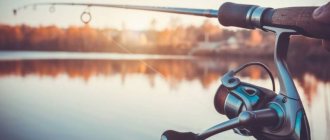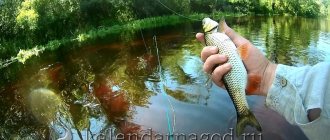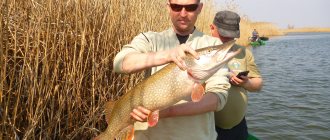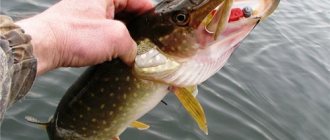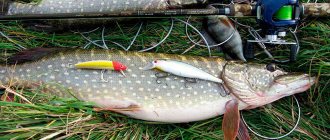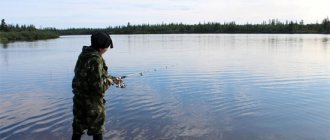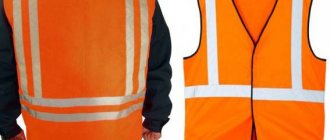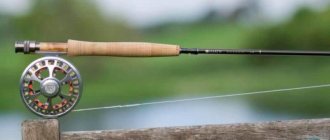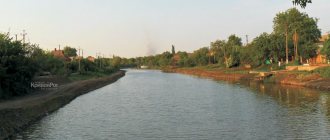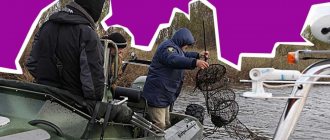The effect of changes in atmospheric pressure on fishing
Atmospheric pressure plays a big role for fishing, especially for those fishermen who return from the pond empty-handed. In this case, the wrong weather was precisely the factor that did not allow the fisherman to take another trophy, although the man sitting on the other bank had everything in order with blood pressure and, as it should, the catch turned out to be decent. But jokes aside, let’s consider the influence of weather conditions, in particular atmospheric pressure, on the activity of fish, and let everyone draw their own conclusion on how to catch it in this or that weather.
Grayling fishing calendar
Grayling fishing can be successful in different seasons of the year. Fish activity often repeats itself month by month from year to year. Therefore, you can create a specific biting calendar.
| January | February | March | April | May | June | July | August | September | October | november | December |
| + | + | ++ | +++ | +++ | +++ | ++ | +++ | +++ | ++ | ++ | +++ |
What is the essence of the question?
First, let's remember our school physics lessons. Atmospheric pressure is a value that characterizes the weight of a column of air per unit area. This value is expressed in millimeters of mercury, according to the method of the scientist Toricelli, which he proposed in 1643.
The normal atmospheric pressure of a mercury column in a glass tube at zero sea level is assumed to be 760. But since the air column decreases with increasing horizon altitude, formulas that take into account two factors are used to recalculate the normal indicator:
- relative height of the place above the sea;
- air temperature.
In the simplest calculations, the influence of air temperature is not taken into account, but the following rule is used:
In other words, if an area with a fish pond is located at an altitude of 120 meters above sea level, a pressure of 750 millimeters of mercury will be considered normal - pH = 760-120/12 = 750.
Pressure change
Now let's talk about how the optimal atmospheric pressure changes. A normal daily fluctuation at which fish bite is considered to be a difference of no more than 3-4 millimeters of mercury. These changes depend largely on the nighttime decrease and daytime increase in air temperature.
More dramatic changes occur with the formation of atmospheric vortices. In this case, the fluctuations are expressed as follows:
- cyclone – pressure drops;
- anticyclone - rising.
Effect on bite
Let's consider the effect of atmospheric pressure on fish biting. First, let's analyze the physical side of the process.
Let us remember that pressure is essentially the weight of air, and a column of water also presses on the fish. So, with an increase in air weight on a fish’s swim bladder, the amount of pressure increases. Therefore, to compensate for this, the bubble is filled with gas and the fish rises to the upper layers, and in the reverse process, it sinks to the bottom.
This change is especially noticeable when fishing for crucian carp, in which gas exchange in the swim bladder is slow compared to other types of fish. So, when the pressure is low, crucian carp sinks to the deepest places in the reservoir, and when the pressure is high, it feeds near the surface.
Photo 1. Quiet weather indicates high blood pressure.
Other fish can also be divided, this division is quite arbitrary, into two categories according to the dependence of their activity on the weather. At high pressure, pelagic fish bite more actively, such as:
With lower atmospheric pressure, almost all predators begin to become more active; remember what kind of weather is called pike weather, and bottom species of peaceful fish:
The dependence of the activity of the predator can be traced by where the small change is located. The pressure increased - it rose to the top, decreased - it went to the bottom. I don’t want to chase loners, I don’t want to change my horizons either, so the predator can’t be caught. It is noted that pike perch bites at any pressure; unlike pike, it hunts in the horizon where its prey is located at that time.
Photo 2. Small ripples on the river indicate a stable bite.
Weather changes
A significant role is played by changes in atmospheric pressure for fishing. It bites better in stable weather, regardless of the number of millimeters of mercury. But the climate that influences biting is constantly changing, so we will characterize all its changes.
- Stable normal pressure is best for catching any fish.
- A good bite is also observed when the atmosphere has a high, stable level of air pressure.
- At a stable low level, the bite will be C-grade, but the predator is active.
- As pressure increases, fish become more active.
- When pressure drops, biting is active in all types of fish.
- Jumping weather is marked by a decrease in fish activity and an almost complete lack of biting.
Photo 3. Table of the dependence of bite on pressure
Ways to catch grayling
To catch beautiful freshwater fish, anglers use several methods.
- A float rod is used for fishing in rivers where there are areas with slow flows and return flows. Fishing is carried out by wire; thanks to this method, the bait is presented to the fish in the most natural way. Fishing requires insect larvae, worms or fry.
- Fly fishing enthusiasts also enjoy productive fishing. With proper selection of flies and precise casting, it is possible to deceive wary fish and tempt them to bite.
- Spinning Grayling on a spinning rod is also actively used by fishermen on rivers and lakes. It is important to find a school of feeding fish and slowly move a small spoon near it.
Grayling on a spinning rod
Best weather for fishing
Based on the above, we can conclude what weather is best for fishing. It should be noted that depending on the fishing season, the dependence of the bite on the pressure does not change, and if in the summer the perch bit better in a particular reservoir at 755 millimeters of mercury, then in the winter you also need to proceed from this indicator.
- If the weather outside is calm and cloudy and has not changed for at least three days, feel free to go fishing for any trophies.
- The decrease in pressure with wind and bad weather is ideal for catching pike and burbot.
Photo 4. Pike wave on a pond.
Thus, we can say that nature has practically no bad weather for fishing. The main thing is to know what type of fish is caught in certain conditions.
The Importance of Atmospheric Pressure for Fishing
Atmospheric pressure affects the behavior of fish. Long-standing observations have clearly shown that at normal pressure, fish feel comfortable. In addition, changes in weather conditions, which are directly related to pressure, can also have an impact. Not all people are susceptible to these changes, and not everyone is aware of how much pressure changes can affect fish. Meanwhile, changes in atmospheric pressure are one of the four most important factors affecting the bite.
Factors on which the bite depends and which you need to know:
- Wrong choice of fishing location;
- Wrong choice of fishing method;
- Time of day and weather conditions;
- A sharp change in atmospheric pressure.
It is impossible to determine the pressure yourself. There is a special device for this called a barometer. The unit of measurement for this indicator is millimeters of mercury (you can also find a measurement option in bars). Pressure happens:
Normal pressure is considered as the pressure of a column of mercury 760 millimeters high at a temperature of 0˚C. Everything above this norm is high blood pressure, everything below is low blood pressure. Within one day, fluctuations not exceeding 3.5 mm are considered normal.
Scientists have little studied the reaction of fish to changes in atmospheric pressure, so you can only rely on those facts that have been confirmed experimentally.
How and why does pressure affect biting?
Fish is a sensitive creature. It reacts to many changes:
- Changes in water level in a reservoir;
- Weather change;
- Reducing water temperature and others.
Of course, fish are affected by changes in atmospheric pressure, however, this does not happen so often. If the pressure changes slowly while the fisherman is fishing, it will not affect the bite in any way.
The following changes may have an impact:
- A decrease in atmospheric pressure to the region's normal limit. Such jumps happen extremely rarely.
- A sharp increase in atmospheric pressure.
- Transitions from high to low atmospheric pressure and vice versa within one day.
In all other cases, the fish is unlikely to behave in any unusual way. Avid fishermen advise fishing not only at normal atmospheric pressure, but also under any stable weather conditions that last for several days in a row.
Weather and grayling bite
As already noted, the grayling bite is as dependent on weather conditions as any white fish. However, grayling is a more active fish, and therefore its metabolism is somewhat accelerated; accordingly, it is more voracious, which means that the weather will have less influence on it. It can be caught in almost any weather, even during periods of sudden weather changes. The only exception can be a sharp frost in the summer or a significant cold snap, when the grayling bite weakens quite significantly.
What the weather can significantly affect is the fishing method. It is known that two main methods are used for amateur fishing: top and bottom. For example, if it gets a little colder, then the flight of insects stops and grayling at this time feeds mainly at the bottom and vice versa, when it warms up, top-mounted baits will have an advantage. The only thing that can seriously affect the grayling bite for the worse is heavy rains. Firstly, this will change the water level in the river, and secondly, the water will become more cloudy and the fish will have to navigate by smell. During this period, it is worth trying live bait (dung worm, for example) and fishing, of course, in the bottom layer.
It has been noticed that during rain, or rather when it just begins to rain, the grayling’s bite on the top trout intensifies. This is due to the fact that flying insects are knocked down by raindrops into the water, and grayling never misses the moment to feast on their favorite prey, which they got so easily. In addition, rain is also an assistant to the fisherman; the ripples formed on the water perfectly hide the presence of the fisherman on the shore, which is an undeniable plus. However, if precipitation in the form of rain drags on, or even intensifies, then the bite begins to gradually weaken and disappears to almost nothing. This is due to the rise of the river level and its turbidity. Grayling loves clean water, and all these circumstances force it to go upstream in search of a cleaner place. At this time, grayling stops being caught. But this applies more often to small rivers, small rivers and streams; large rivers are deprived of this and fish in them continue to be caught using bottom gear, but less actively.
Fishing at low pressure
In fact, you can fish in any weather conditions and at any atmospheric pressure.
At low pressure it is advisable to catch predatory fish. Low pressure makes the fish passive. She goes to the bottom. This situation provokes predators to hunt. That is why at low pressure you can catch pike, burbot, pike perch, perch and catfish well. This observation is true when it comes to stable low blood pressure. With sudden changes, any fish becomes lethargic and you should not expect a rich catch.
If you don’t have a barometer at hand, you can independently determine that the pressure has decreased by some signs:
- The smoke from the fire spreads low and practically does not dissipate.
- Foam appears in the water near the shore.
Fishing at high pressure
High blood pressure affects fish in a completely different way.
The predatory fish becomes lethargic and sinks to the bottom. Predators do not like the sun, and in the summer, with high pressure, it is always clear and warm. Consequently, predatory fish are affected not by the increased pressure itself, but by the weather conditions associated with it (clear weather, increased air and water temperatures). At high pressure, white fish are caught well. It becomes active, and if the fisherman is determined to get a good catch, he needs to develop tactics for catching this particular type of fish.
At elevated atmospheric pressure the most mobile are:
There are exceptions among predators. At high blood pressure the following are quite active:
Most often, fishing is done at dawn. This is especially true in the summer, since in the morning the water is not yet warmed up under the bright rays of the sun, and the fish swim closer to the surface.
It is important to understand that:
- The factor of water heating due to sunlight has a much greater effect on fish than changes in atmospheric pressure.
- It is very difficult to take into account all the factors; there are many of them, and not all of them can be applied to a specific region.
- Each fisherman has his own rules for fishing in certain conditions.
Reasons for changes in fish behavior
If the sense of touch is normal, the fish sees the food perfectly, feels great and there is no need for it to reduce its activity.
The sense of touch of fish is vaguely similar to the principle of operation of an echo sounder.
When moving, the fish creates barely noticeable waves, allowing it to navigate and determine the correct distance to various objects located in the water column.
In addition, thanks to these waves, the fish accurately determines the depth at which it is located.
This works best for surface fish. The fish orients itself and determines the distances to various objects in the thickness of the reservoir according to a specific density. As the pressure rises, the water level drops slightly, causing its density to increase.
At the same depth, the fish begins to feel discomfort and moves higher. Now the waves created by the fish carry information that is unusual for it and it is necessary for some time to pass until it adapts.
After the acclimatization period is completed, the fish feels good closer to the surface of the water, where it is easier to get food. Therefore, the bite of white fish increases as soon as the barometer creeps up.
As the whitefish moves closer to the surface, the predators have no one to hunt, so their activity subsides.
As soon as the barometer starts to creep down, the white fish is not comfortable in the upper layers and sinks deeper. Again the waves it creates carry unfamiliar information; again the fish needs to get used to new conditions.
It is because of these periods of acclimatization that there is no bite during sudden pressure surges.
Having descended to the depths, the whitefish again becomes a tasty prey for a predator. Therefore, when the barometer falls, predatory fish are more likely to bite.
Ideal atmospheric pressure for fishing
Before defining what atmospheric pressure can be considered ideal, it is important to note another parameter well known to avid fishermen - wind. It directly depends on pressure fluctuations. It is important to remember a few rules related to wind:
- If the wind is north or north-west, then crucian carp is caught well at this time.
- The south wind has a positive effect on carp and carp.
The only thing that is known for certain is that sudden changes in pressure, including those close to critical levels, certainly have a bad effect on the bite.
A normal pressure of 760 mm with a deviation of no more than 3 mm is considered ideal for fishing, but some fishermen prefer to fish at low pressure.
When coming to a river or lake, a fisherman must realize that fish are part of a huge ecosystem in which changes in atmospheric pressure are a common thing. Pressure changes are not unusual, but they affect fish in combination with many other variable factors, so it is impossible to accurately predict the size of the catch.
Influence of atmospheric pressure depending on the season
Spring bite
The most wonderful time for fishing is early spring, when the water temperature begins to rise, hungry predators, and most of the ichthyofauna are actively biting on any bait.
The bite may drop due to gusty winds, a sharp drop in temperature and strong pressure surges.
From mid-April, the fish become more picky and willingly bite in light winds and stable weather throughout the day. She is also reluctant to take bait in cloudy waters, which is associated with melting snow.
Summer bite
In summer, when the water rises to more than 25 degrees, the fish becomes apathetic, and its behavior is highly dependent on atmospheric pressure. Cloudy but windless days are considered optimal weather for fishing.
The predator takes bait well on days with short thunderstorms. It is best to go fishing either at dawn or at night, when the temperature is slightly lower than during the day.
Autumn bite
In the fall, as soon as the temperature drops, the fish begin to actively take the bait. For fishing in the autumn season, it is better to choose warm days with light winds.
Pike bite more actively in September on cloudy days, until the first cold, then the bite drops. But carp breeds have low activity in the fall.
Winter bite
In winter, most fish are very susceptible to pressure fluctuations. If it has changed up and down several times in a short period of time, you should not expect a good bite, even if it stabilizes. It needs to stay at the same level for 2-5 days, then there will be a bite.
Whether there will be a bite or not depends very much on the combination of ambient temperature and pressure. So, if in winter the barometer rises by 25-30 mm, and the thermometer drops by 7-12 degrees, you can’t expect a bite.
Also in winter there will be no bite if it drops by 9-11 mm and at the same time the temperature changes. The bite will resume only when these parameters stabilize.
The bite will be good if high pressure is combined with low air temperature, and low pressure will be on days of thaw and mild frosts.
To decide which pressure is best for fishing, you must first decide what you want to catch and then, depending on the season, choose the optimal days for fishing.
Feeding pressure and activity of predatory fish.
Among the many natural factors influencing the feeding activity of predatory fish, the main one is atmospheric pressure, while the rest are secondary. Over the course of three years, this assumption was tested and we were convinced of its correctness. This was the reason for formulating the following practically valuable rule for biting intensity: the feeding activity of predatory fish increases sharply with any decrease in atmospheric pressure, and the faster this decrease occurs, the higher the activity of the predator.
The fact that fish bite depends on atmospheric pressure, I think, does not require proof. Another question is how to determine the extent of its influence for practical use. If we approach this problem only from the point of view of the correspondence of the pressure level to a specific fish activity in a certain time period, for example, in the first ten days of June at 740 mm Hg. – such, at 755 mm Hg. - this kind of thing, then this, it seems to us, will lead to an error in deciphering the very pattern of biting. After all, the pressure level almost always fluctuates, i.e. either rises or falls, staying only for a short time at some constant value (which most often happens at night). And long-term observations also allowed us to conclude that the very level of atmospheric pressure at a given time does not have a significant effect on the feeding activity of fish. But the fish perceives only the process of changing atmospheric pressure: increase, decrease and stop. Therefore, we boldly excluded specific numerical values from further analysis. Now let’s look at these three main phases of the movement of the atmospheric pressure level, and how they affect the fish’s bite.
Decrease in atmospheric pressure level.
As soon as the pressure begins to decrease, the highest feeding activity of predatory fish (zhors) is observed. At the same time, all other natural factors - wind, moon phases, sun - have practically no effect on it. The bite is excellent in any wind or completely calm, with a full moon or a weak one. Even in bright sunshine, the bite is excellent (if you use “sunny” colors of bait), and the time of day does not matter - as long as it is light. And for successful fishing you only need one more thing - the presence of predatory fish in the place where you are fishing.
The bite intensifies greatly if the pressure drops very quickly, and previously there was weather with high pressure for a day or two. Moreover, it is most intense for several hours immediately after the start of the decrease in pressure, but gradually worsens (the fish become saturated). A particularly rapid subsidence of the bite is observed when such a decrease in pressure occurs for the second or third time in a row - by that time the fish is already standing with a full stomach.
Even a slight drop in atmospheric pressure (by 2-3 mm Hg) - if before this there was a phase of increasing or stabilizing pressure - leads to an increase in feeding activity and a very good bite.
During this period of active feeding, baits that imitate fish are preferred: wobblers, spoons, vibrotails, foam fish, etc. If the weather is sunny during fishing, then it is better to use baits of the following colors: red, red-yellow, dark colors.
In the middle of summer, with a large number of periods of stabilization and increase in atmospheric pressure, the fish bite becomes noticeably worse (although many consider the main reason for this to be an increase in water temperature). Then it helps to achieve some results by using to catch moments of minor fluctuations (drops) in atmospheric pressure (by an amount of about 1-3 mm Hg), most often in the evening or in the morning. These pressure fluctuations occur as a result of changes in atmospheric fronts of different levels, and the fish always take well at this time, although the most favorable bite occurs during the passage of atmospheric fronts with low pressure or, more simply, cyclones.
Let's consider periods of favorable fish biting during the passage of a cyclone. Most of them have the same structure. The television weather forecast shows us the following picture:
1 – the first period of decrease in atmospheric pressure occurs at the beginning of the cyclone’s entry into the territory of your area; At the same time, the weather is still good and clear. Perhaps the best time for catching predatory fish, which begins to feed intensively, and windy days are pleasant for the fisherman himself.
2 – the second period of decrease in atmospheric pressure, when we are already inside the cyclone area, occurs when a rain front enters the same area. This is also a fairly powerful drop in pressure levels, which means it’s time for a good bite. However, you should not get lost in the excitement, otherwise successful fishing may “unexpectedly” end in heavy rain that will last for a very long time. Then, after this shower, there will be a period of stabilization of atmospheric pressure.
Cyclones can have other compositions of rain fronts, but the most common is the one we have considered.
An excellent catch is likely during a sharp drop in atmospheric pressure as a result of the activity of thunderstorm fronts or even a single thundercloud: the fish bite in this short period is simply excellent. If after a thunderstorm (or just rain) the atmospheric pressure stabilizes or begins to increase, then the activity of the fish almost stops - and a change of bait is required. If the pressure continues to decrease, then the good bite does not stop, and you just need to take into account that after a particularly strong thunderstorm, the fish may be in deeper places in the reservoir.
Atmospheric pressure stabilization phase (rest)
Stabilization of atmospheric pressure occurs after the completion of periods of both increase and decrease in pressure, essentially separating them. Over a certain period of time (usually lasting several hours, sometimes more - for example, the whole night) its level does not change. The maximum duration periods of stable atmospheric pressure were noted in the middle of the summer period. During such stabilization, the bite is the worst, one can even talk about its absence, i.e. the fish seems to be in an indefinite state of vital activity (often in a state of rest), and stops feeding.
If the stabilization period begins after the pressure drop phase, then the fish, as if by inertia, continues to feed for about an hour, after which the biting stops. The attacks of the predator at this time are sporadic, and only if you teased him in some way, for example, by hitting the bait directly into a school of resting fish. Therefore, it is incorrect to talk about a complete lack of bite, even during this unfavorable period for fishing.
Increasing atmospheric pressure levels
The phase of increasing atmospheric pressure is a time of “abstinence” for predatory fish. The predator stops hunting for healthy small fish (or, as another way to put it, his “food activity” disappears), and he goes from an active state to a passive one. A normally aggressive predator can now stand indifferently all day among a school of small fish, even while remaining hungry.
The small fish, sensing the current passivity of the predator, takes advantage of this for active feeding, and without this period, the small fish would not be able to feed adequately, because. the presence of predators in most reservoirs is very significant, and the pressure from them on small fish is great.
At this unfavorable time for predatory fish, it begins to look for food of a completely non-fishy nature, i.e. insects, worms, frogs, tadpoles, mice, as well as dying fish or their remains. Therefore, its bite is of a specific nature, and the basis for successful fishing are “flies” (fly fishing type), baits with a twister, spinner baits, plastic or natural frogs, dead fish or pieces of it. In this case, the predator will always grab not the spoon itself, but any “offal” that is nearby.
At sunrise and sunset, the bite of predatory fish may become somewhat more active, and it is worth using a “slow” wobbler, a foam fish, or a vibrating tail. But it is necessary to guide the “dying fish” (scraping along the bottom, frequent stops and other techniques): the more it resembles a sick individual, the better. But you can’t count on any special biting activity, even at dawn. During this period, it is always necessary to tease the fish, and a good catch is only possible with professional fishermen, and even then not always, because... If the fish is not hungry, nothing can tempt it.
It has also been noted that the catch is getting smaller—mostly small specimens of the predator are caught, and trophy ones are very rare: the larger the fish, the stronger the degree of its dependence on the “food activity” factor.
It is impossible to unambiguously divide fish into predatory and non-predatory, so our conclusions are most likely applicable to all fish without exception. You just need to take into account that during a surge in predator activity, most small fish have to stop normal feeding and simply hide, or make forced migrations to areas of the reservoir where there are fewer hunters for them.
One can assume another reason for the increased “feeding activity” of predatory fish during the period of decreased atmospheric pressure - the fear of remaining hungry for a long time due to bad weather, because a drop in pressure and tells her about impending bad weather.
Using the derived rule has already given us the opportunity to increase our catches several times and avoid unsuccessful fishing trips, achieving good results on any day. I hope this article will be interesting and useful to fellow fishermen.
How to catch grayling
Tackle for catching grayling should be distinguished by the lightness of the forms and components of the equipment, as well as the subtlety of installation.
Important! Hunting for this representative of salmon fish is quite dynamic and requires constant monitoring of baits, and for fly fishing, special training in the skill of casting a fly.
When completing tackle for spinning, float and fly fishing, select the lightest graphite rod, the use of which will not tire the angler with frequent casts. For cords, nylon fishing lines are used, which perfectly dampen the jerks of caught fish, and hooks are used with an elongated shank, size 10–12. Wade fishing is always more successful than shore hunting, and the presence of waders for an angler will help to significantly increase the number of catches. The angler will learn about the features of using various fishing methods and baits depending on the season of the year from further material in the article, with a focus on the main nuances of the technology.
in spring
For still muddy spring waters, the use of float gear is justified, with the help of which baits of animal origin are placed in the middle water levels above the places where the fish are supposed to stay.
Important! The speed of the wiring is comparable to the speed of the current without delays or stops. The nature of the presentation of an insect, thin dung worm, bloodworm or maggot does not cause suspicion in the fish and if the presentation trajectory is successful, it will definitely take the bait.
Fishing using bombards and wobblers with low-frequency, not sweeping action is effective. The float should keep the bait in the middle water horizon, and the wiring itself is performed at an average pace of winding the cord without pauses or freezes.
In summer
In the summer, fly fishing becomes the priority method of catching predators. Fishing is done from the surface using a dry fly as bait. Fly fishing for grayling on riffles and rapids brings more bites than on the borders of fast and standing water. After casting, the fly is allowed to swim along the surface with slight twitches and pauses. The slightest touch of the bait by the fish is accompanied by an energetic hook. Long distances are fished using a floating bombard, relocating the predator's supposed stopping place. Bringing the fly to a promising point, they make holds and pauses, at the moment of which the bite occurs.
in autumn
In the fall, fly fishing continues, but the best fly will be in the wet version. The predator stops taking bait from the surface and begins to hunt in the water column. Spinning fishing using small spinners and silicone can be superior to fly fishing in terms of catchability. Uniform movements, without touching the bottom, are carried out on rapids and on the trajectories of contact of the main current with the creeks. In the fall, it is justified to use a boat equipped with both artificial flies and hooks with bloodworm and maggot attachments.
in winter
After the pond freezes, fishing is carried out with winter fishing rods, light balalaikas, with the installation of jigs and replanting bloodworms on them. The bait is played in the water column, making low throws alternating them with a short pause. On currents, they use the ice fishing technique using float equipment, placing an artificial fly as bait, which is fed into the middle horizons of the water and lures a predator, playing with the force of the current. Fishing with winter baits placed along the stream using flies or small silicone as bait is no less productive.
Grayling fishing calendar
| Month | Biting activity | Lures and tackle used | Additional Information |
| January | Relatively weak bite | For fishing, winter fishing rods and vertical lures are used. | In cold regions, grayling will bite poorly. In regions with temperate climates, the bite is noticeably higher |
| February | Weak, sometimes average level of bite | Winter gear and vertical trolling method are used | Similar situation as in January |
| March | Weak, sometimes average level of bite | Fishing is done with winter gear and vertical lures | At the end of March, the flood begins and bite rates will drop noticeably |
| April | No bite | You can catch grayling only in the northern regions | The fish goes to spawn |
| May | High bite rates | Grayling is caught with float rods, fly fishing and spinning rods | Grayling bites well on worms, maggots and bark beetle larvae |
| June | Bites well | For fishing, float rods, fly fishing and spinning are used. | On rivers, grayling is caught using worms and flying insects. |
| July | High bite rates | Spinning, float tackle, fly fishing | In hot weather, the fish stands at depth, under streams of cold water |
| August | High biting level | Ideally, hunt grayling with a spinning rod | Grayling continues to hunt and is actively fattening |
| September | High biting level | The best way to catch grayling is in the wire | Fish stand in deep holes and on rifts |
| October | High bite rates | Catch with float tackle, wire or donk | Grayling stands on riffles and at depth in holes |
| November | Weak bite level | Fished using winter gear, float rods and the vertical lure method. | Fish can be caught in open reaches or near deep holes |
| December | Weak bite | Winter tackle and vertical lure | The fish go to the depths of the rivers, to areas with an average flow level |
Peculiarities of grayling behavior
Let us immediately note that grayling does not make large migrations across the local water area, much less beyond its borders. The greatest distance that a fish can travel for any reason will not exceed 50 km. Most often, grayling overcomes such distances in early spring, moving upstream to spawn or feed. Around mid-autumn, the fish return back, but for the winter.
The life of grayling takes place within a certain area. Graylings of different species do not interbreed. Quite often, even in bodies of water bordering each other, you can find large populations of graylings that do not intersect with each other throughout their entire lives.
The types of grayling differ in their lifespan, growth, habits and fattening. Let us note that there is lake grayling, which only comes out to feed in still water; it does not like currents, unlike river grayling. But there is also a population of lake graylings, which, during floods, leave the lakes and make transitions into rivers, where they spend the entire summer, and return to the lake only closer to winter.
Graylings living in rivers spend the winter in deep holes, but with the arrival of spring they move to the upper reaches of the river. When the flood comes, river grayling enters the tributaries to spawn. With the first autumn cold, grayling returns back to the lower reaches, lies down in pits, where it spends most of the winter period.
Lunar calendar for grayling fishing
Grayling fishing will depend on the phase of the moon:
- New moon. During this period, grayling bites reluctantly. The biting rates decrease a couple of days before the appearance of the new moon and recover after 2-4 days from the new moon;
- Crescent. The bite is getting noticeably better. This period lasts 2-3 days;
- Full moon. During this period, grayling behaves actively and the bite improves noticeably;
- Last quarter. The most active period of biting. The period of active feeding lasts about a week.
By taking these factors into account, you can seriously increase your chances of success.
Spinning fishing
Spinning allows you to purposefully hunt for trophy grayling. In adult individuals, pronounced predatory tendencies appear. Therefore, small spoons, wobblers and silicone fish can bring a worthy trophy.
To collect catchable tackle you will need:
- light rod 2.1-2.4 m long with casting up to 7 g;
- “meat grinder” size 2000-2500 with a gear ratio of 5.1:1;
- braided cord 0.10 mm thick;
- set of artificial baits.
When fishing with a spinning rod, an angler must remember one feature of grayling. This fish will not catch up with a fast-swimming wobbler or spinner. Only a slow, even retrieve will allow you to see the bite. Therefore, only high-quality baits that work actively at low speeds can interest grayling.
Catching grayling with a spinning rod in Siberia
